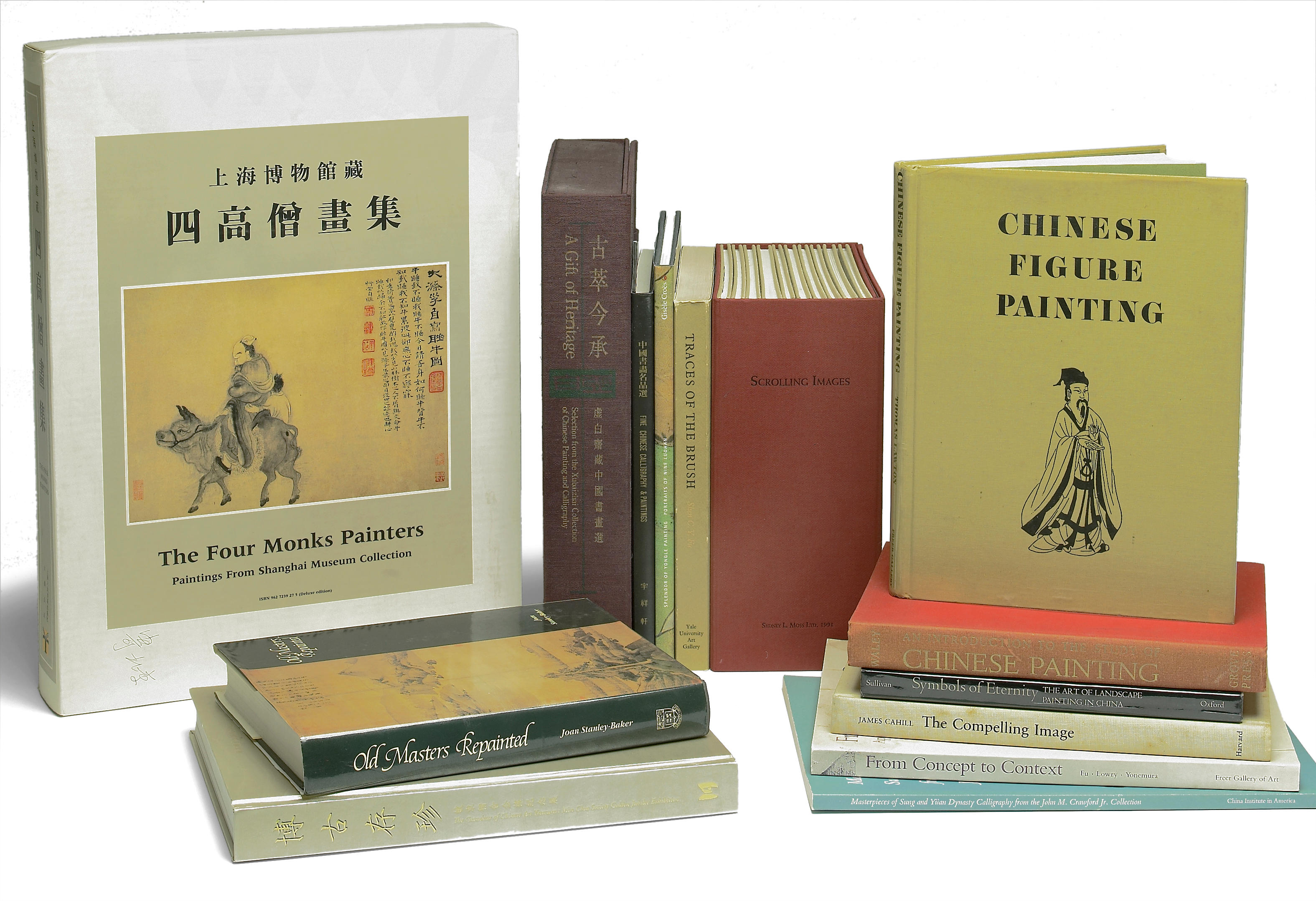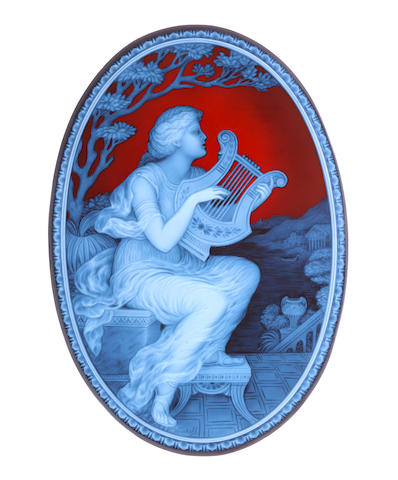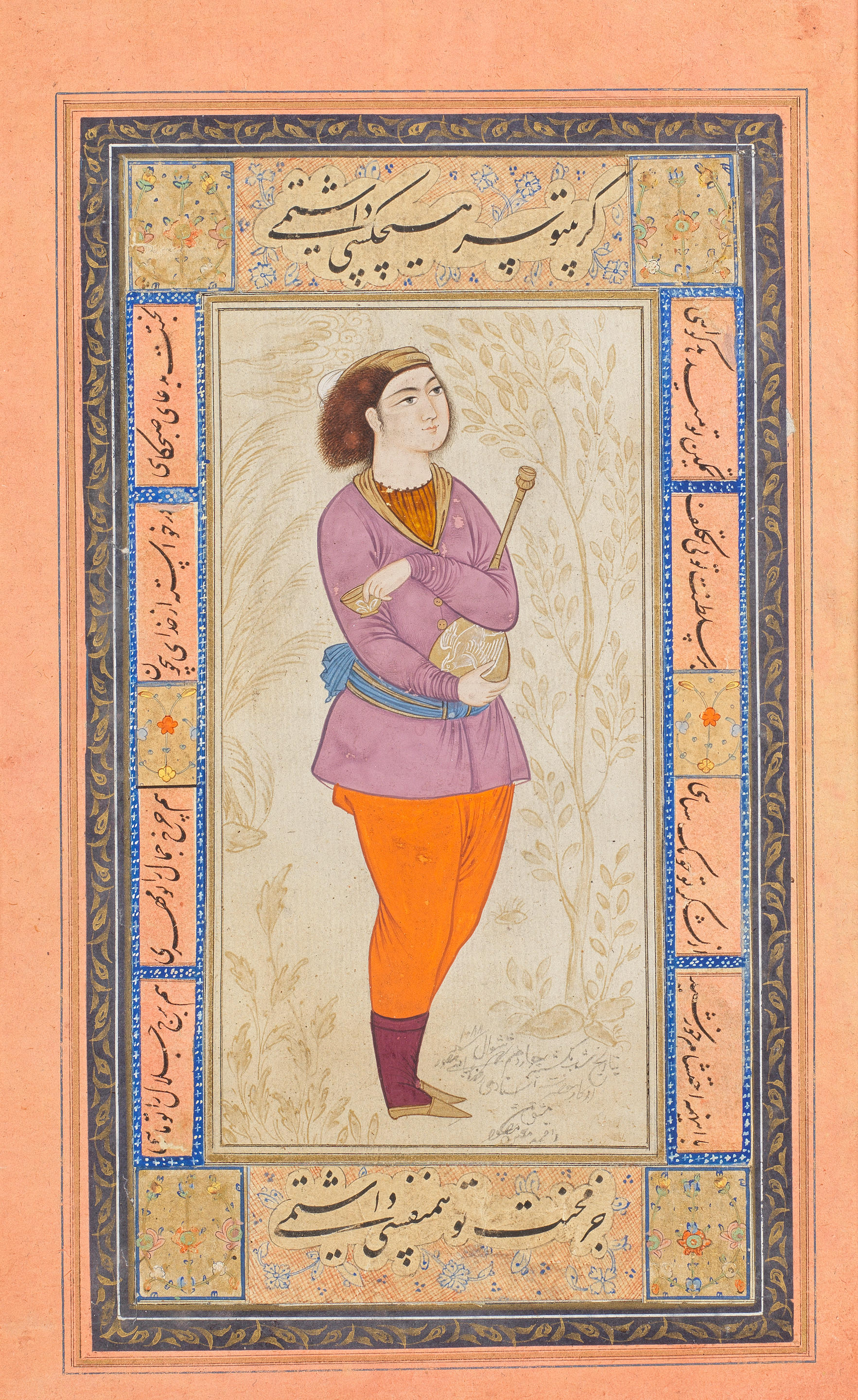The Origin of Painting: An important cameo glass vase by George Woodall late 19th century Owned by the artist, the tapering ovoid form overlaid in opaque white and carved through to the raisin brown glass beneath, the figure subject representing the myth of Fielea and Ariston, Cupid encouraging the maiden to sketch the silhouette of her Corinthian lover on the wall as a permanent reminder of his youthful beauty, his shadow cast by torchlight and a hanging lamp behind them, the neck with a band of pendant swags, a deeply cut geometric border to the base, the reverse with an artist's palette and brush, signed 'Geo Woodall' and titled on the underside, 23cm high Fußnoten Provenance Woodall Family Collection Literature Illustrated by Ray and Lee Grover, Carved & Decorated European Art Glass (1970), pl.33 Illustrated by Ray and Lee Grover, English Cameo Glass (1988), p.112, fig.118 Illustrated by Christopher Woodall Perry, The Cameo Glass of Thomas and George Woodall (2000), p.64 The story of the Maid of Corinth, otherwise known as The Origin of Painting, inspired many artists and a number of versions of the subject have been incorrectly suggested to have been the inspiration for George Woodall's masterpieces. The actual source is the painting by Giovanni Battista Cipriani (Italian, 1727-1785), most likely via a print by Louis Charles Ruotte The first piece bearing this subject produced by George Woodall is likely to have been the circular plaque signed and dated 'G Woodall 1884' (GW1300 in the Thomas Webb and Sons price book). Formerly in the Rakow Collection, it is now in the Corning Museum of Glass, accession no. 89.2.15, illustrated by David Whitehouse, English Cameo Glass in the Corning Museum of Glass (1994), p.38, pl.33. The first vase depicting The Origin of Painting is signed and dated 'G Woodall 1887' (W1797) and sold immediately after its completion. It was photographed by the master himself, and his image is reproduced from the original glass-plate negative by Perry (2000), p.31. It is likely that this is the same vase as that from the Karin and Dr Ernest H Rieger Collection, illustrated by Ray and Lee Grover (1988), pl.C203, and sold by Woody's Auctions in Wichita on 29 May 2014. Following the success of the first vase, a second bearing the subject was commissioned by a Mr Nett at around the same time (W2457). Illustrated by Ray and Lee Grover, pl.C202, this vase was sold by Bonhams on 18 May 2016, lot 249. A second plaque bearing the subject was completed some years later in September 1910 (GW145), and a photograph of this taken by George Woodall is reproduced by Perry, p.113. This plaque was destroyed in a fire at the Brussels exhibition in that year, in what George Woodall described as 'the worst thing that has ever happened to my work'. A replacement was created using the insurance money (GW145b). Formerly in the Bill and Irma Runyon Collection, this plaque was in the Webb's Museum until 1982 and is now in the MSC Forsyth Centre Galleries in Texas A & M University, accession no. 988.001.0107. Unsigned and unmarked, it is believed that George Woodall was still working on this piece in 1920, long after he had retired; see Charles Hajdamach, 20th Century British Glass (2009), pp.68-71 and pl.136. The present lot is the third and final known version of The Origin of Painting on a vase. As it was George Woodall's personal copy, it is not listed in the Thomas Webb and Sons price book but is likely to have been completed not long after the second vase was sold in the late 1880s; the shape is paralleled by a vase with the subject of Diana and the Nymph, dated 1891 (W2718). Upon his death, The Origin of Painting passed to his second daughter Alice. It was recovered from a floor safe in Luton House, the family home in Kingswinford, which contained two other pieces of cameo glass (two plaques receptively showing 'Aphrodite Rising from the Waves' and 'Sappho') when she died in 1954. This lot and the plaque showing Aphrodite
The Origin of Painting: An important cameo glass vase by George Woodall late 19th century Owned by the artist, the tapering ovoid form overlaid in opaque white and carved through to the raisin brown glass beneath, the figure subject representing the myth of Fielea and Ariston, Cupid encouraging the maiden to sketch the silhouette of her Corinthian lover on the wall as a permanent reminder of his youthful beauty, his shadow cast by torchlight and a hanging lamp behind them, the neck with a band of pendant swags, a deeply cut geometric border to the base, the reverse with an artist's palette and brush, signed 'Geo Woodall' and titled on the underside, 23cm high Fußnoten Provenance Woodall Family Collection Literature Illustrated by Ray and Lee Grover, Carved & Decorated European Art Glass (1970), pl.33 Illustrated by Ray and Lee Grover, English Cameo Glass (1988), p.112, fig.118 Illustrated by Christopher Woodall Perry, The Cameo Glass of Thomas and George Woodall (2000), p.64 The story of the Maid of Corinth, otherwise known as The Origin of Painting, inspired many artists and a number of versions of the subject have been incorrectly suggested to have been the inspiration for George Woodall's masterpieces. The actual source is the painting by Giovanni Battista Cipriani (Italian, 1727-1785), most likely via a print by Louis Charles Ruotte The first piece bearing this subject produced by George Woodall is likely to have been the circular plaque signed and dated 'G Woodall 1884' (GW1300 in the Thomas Webb and Sons price book). Formerly in the Rakow Collection, it is now in the Corning Museum of Glass, accession no. 89.2.15, illustrated by David Whitehouse, English Cameo Glass in the Corning Museum of Glass (1994), p.38, pl.33. The first vase depicting The Origin of Painting is signed and dated 'G Woodall 1887' (W1797) and sold immediately after its completion. It was photographed by the master himself, and his image is reproduced from the original glass-plate negative by Perry (2000), p.31. It is likely that this is the same vase as that from the Karin and Dr Ernest H Rieger Collection, illustrated by Ray and Lee Grover (1988), pl.C203, and sold by Woody's Auctions in Wichita on 29 May 2014. Following the success of the first vase, a second bearing the subject was commissioned by a Mr Nett at around the same time (W2457). Illustrated by Ray and Lee Grover, pl.C202, this vase was sold by Bonhams on 18 May 2016, lot 249. A second plaque bearing the subject was completed some years later in September 1910 (GW145), and a photograph of this taken by George Woodall is reproduced by Perry, p.113. This plaque was destroyed in a fire at the Brussels exhibition in that year, in what George Woodall described as 'the worst thing that has ever happened to my work'. A replacement was created using the insurance money (GW145b). Formerly in the Bill and Irma Runyon Collection, this plaque was in the Webb's Museum until 1982 and is now in the MSC Forsyth Centre Galleries in Texas A & M University, accession no. 988.001.0107. Unsigned and unmarked, it is believed that George Woodall was still working on this piece in 1920, long after he had retired; see Charles Hajdamach, 20th Century British Glass (2009), pp.68-71 and pl.136. The present lot is the third and final known version of The Origin of Painting on a vase. As it was George Woodall's personal copy, it is not listed in the Thomas Webb and Sons price book but is likely to have been completed not long after the second vase was sold in the late 1880s; the shape is paralleled by a vase with the subject of Diana and the Nymph, dated 1891 (W2718). Upon his death, The Origin of Painting passed to his second daughter Alice. It was recovered from a floor safe in Luton House, the family home in Kingswinford, which contained two other pieces of cameo glass (two plaques receptively showing 'Aphrodite Rising from the Waves' and 'Sappho') when she died in 1954. This lot and the plaque showing Aphrodite















Testen Sie LotSearch und seine Premium-Features 7 Tage - ohne Kosten!
Lassen Sie sich automatisch über neue Objekte in kommenden Auktionen benachrichtigen.
Suchauftrag anlegen